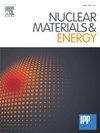The study of neon retention and release behaviour from Be layers deposited under distinct temperature, pressure and ion energy conditions
IF 2.3
2区 物理与天体物理
Q1 NUCLEAR SCIENCE & TECHNOLOGY
引用次数: 0
Abstract
The purpose of this work is to carry out a systematic parametric study on neon (Ne) retention and release behaviour from Be/Ne layers co-deposited under ITER-relevant conditions, in terms of deposition temperature, gas pressure and ion energy. This study incorporates analyses of structural and morphological properties of Be/Ne coatings, along with Ne retention/release behaviour. A total of 27 batches of Be/Ne layers were deposited onto silicon (Si) and tungsten (W) substrates by adjusting to several selected values (i) the working gas pressure (1 Pa, 2 Pa, 3 Pa), (ii) the ion energy of the plasma species (30 eV, 100 eV, 200 eV) and (iii) the substrate temperature during deposition (340 K, 473 K, 573 K). The chosen deposition method was the novel Bipolar-High Power Impulse Magnetron Sputtering (BP-HiPIMS) technique due to its high ionization degree of the plasma species and its versatility in controlling the ion flux and energy during the deposition process. For a more comprehensive understanding, of how plasma properties, coatings’ structure, retention and release behaviour of Ne from the deposited samples correlate to each other, plasma-diagnosis was performed. The influence of gas pressure and pulsing configuration on ion energy and flux was investigated. The coating’s morphology and microstructure were analysed by Scanning Electron Microscopy (SEM), Atomic Force Microscopy (AFM) and X-ray diffraction (XRD). The surface’s morphology of the Be-Ne layers deposited at 340 K indicates smooth layers, with surface roughness values independent of the working gas pressure and ion energy. SEM images of the layers produced at temperatures higher than 340 K suggest the formation of blister-like structures on their surface. Unsurprisingly, the crystalline structure is strongly dependent on the substrate temperature. Metallic Be crystalline phase is observed for layers deposited at 473 K and 573 K, while, for the lowest substrate temperature (340 K), the structure of the Be-Ne layers was found to be amorphous, regardless of the working gas pressure and/or ion energy used during the deposition process. Ne/Be ratio in the deposited layers was evaluated through Thermal Desorption Spectroscopy (TDS) measurements. The results show an increase in the Ne content in layers with the increase of working gas pressure and ion energy. Although the Ne inventory is released above 1000 K, the increase of substrate temperature during deposition changes the microstructure of the Be layer, leading to a significantly lower Ne retention. The empirical scaling equation was developed assuming that the Ne/Be ratio is proportional to the deposition rate of Be and the ion energy, obeying an Arrhenius-type temperature dependence. The resulting model accurately fits the experimental data obtained for the following conditions: substrate temperature 473 K ≤ T ≤ 573 K; deposition rate 0.04 nm/s ≤ rd ≤ 0.12 nm/s; ion energy 30 eV < En < 200 eV.
求助全文
约1分钟内获得全文
求助全文
来源期刊

Nuclear Materials and Energy
Materials Science-Materials Science (miscellaneous)
CiteScore
3.70
自引率
15.40%
发文量
175
审稿时长
20 weeks
期刊介绍:
The open-access journal Nuclear Materials and Energy is devoted to the growing field of research for material application in the production of nuclear energy. Nuclear Materials and Energy publishes original research articles of up to 6 pages in length.
 求助内容:
求助内容: 应助结果提醒方式:
应助结果提醒方式:


